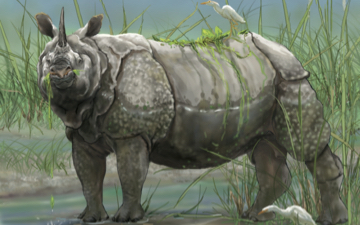The Indian rhinoceros (Rhinoceros unicornis), also called the Indian rhino, greater one-horned rhinoceros or great Indian rhinoceros, is a rhinoceros species native to the Indian subcontinent. It is listed as Vulnerable on the IUCN Red List, as populations are fragmented and restricted to less than 20,000 km2 (7,700 sq mi). Moreover, the extent and quality of the rhino’s most important habitat, the alluvial Terai-Duar savanna and grasslands and riverine forest, is considered to be in decline due to human and livestock encroachment. As of August 2018, the global population was estimated to comprise 3,588 individuals, including 2,939 individuals in India and 649 in Nepal.[1] Kaziranga National Park alone had an estimated population of 2,048 rhinos in 2009.[2] Pobitora Wildlife Sanctuary in Assam has the highest density of Indian rhinos in the world with 84 individuals in an area of 38.80 km2 (14.98 sq mi) in 2009.[3]
The Indian rhinoceros once ranged throughout the entire stretch of the Indo-Gangetic Plain, but excessive hunting and agricultural development reduced its range drastically to 11 sites in northern India and southern Nepal. In the early 1990s, between 1,870 and 1,895 rhinos were estimated to have been alive.[4] Since then, numbers have increased due to conservation measures taken by the government. However, poaching remains a continuous threat, as more than 150 rhinos were killed in Assam by poachers between 2000 and 2006.[5]
Nearly 85% of the global Indian rhinoceros population is concentrated in Assam, where Kaziranga National Park contains 70% of rhino population.
The Indian rhino has a thick grey-brown skin with pinkish skin folds and one horn on its snout. Its upper legs and shoulders are covered in wart-like bumps. It has very little body hair, aside from eyelashes, ear fringes and tail brush. Males have huge neck folds. The skull is heavy with a basal length above 60 cm (24 in) and an occiput above 19 cm (7.5 in). The nasal horn is slightly back-curved with a base of about 18.5 cm (7.3 in) by 12 cm (4.7 in) that rapidly narrows until a smooth, even stem part begins about 55 mm (2.2 in) above base. In captive animals, the horn is frequently worn down to a thick knob.[14]
The Indian rhino’s single horn is present in both males and females, but not on newborn calves. The horn is pure keratin, like human fingernails, and starts to show after about six years. In most adults, the horn reaches a length of about 25 cm (9.8 in), but has been recorded up to 36 cm (14 in) in length and 3.051 kg (6.73 lb) in weight.[18]
Among terrestrial land mammals native to Asia, the Indian rhino is second in size only to the Asian elephant. It is also the second-largest living rhinoceros, behind only the white rhinoceros. Males have a head and body length of 368–380 cm (12.07–12.47 ft) with a shoulder height of 170–186 cm (5.58–6.10 ft), while females have a head and body length of 310–340 cm (10.2–11.2 ft) and a shoulder height of 148–173 cm (4.86–5.68 ft). The male, averaging about 2,200 kg (4,850 lb) is heavier than the female, at an average of about 1,600 kg (3,530 lb).[19]
The rich presence of blood vessels underneath the tissues in folds gives them the pinkish colour. The folds in the skin increase the surface area and help in regulating the body temperature.[20] The thick skin does not protect against bloodsucking Tabanus flies, leeches and ticks.[14]
The largest individuals reportedly weighed up to 4,000 kg (8,820 lb).[21]
(From Wikipedia, June 2021)




